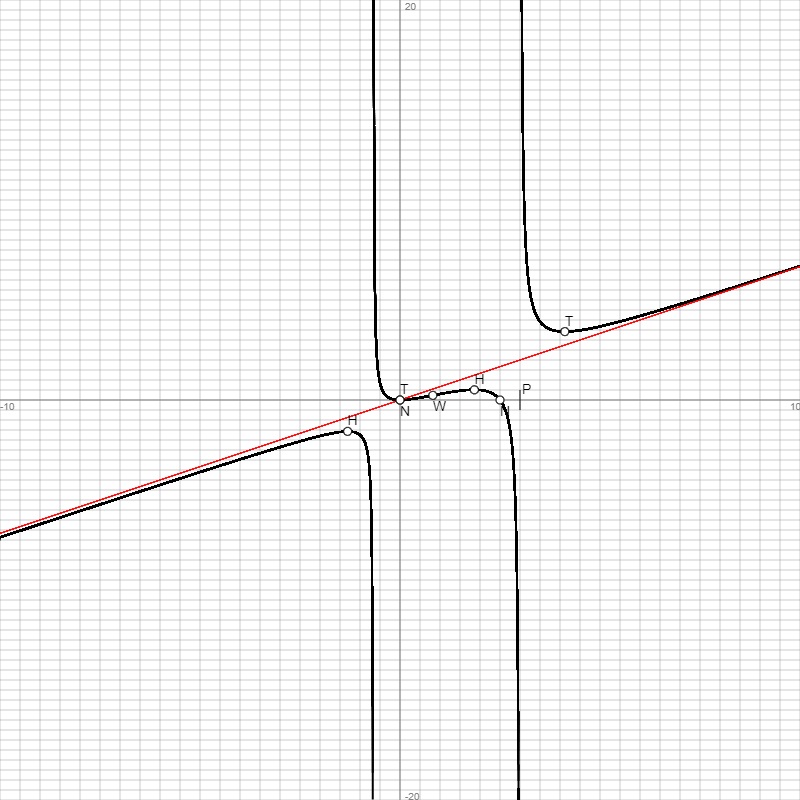 , Df = R\{-2/3; 3}, Wf = R, gebrochen rationale Funktion (in Produkt-/Linearfaktordarstellung), x -> -∞: f(x) -> 2x/3 = y als Grenzkurve, x -> +∞: f(x) -> 2x/3 = y als Grenzkurve ->
, Df = R\{-2/3; 3}, Wf = R, gebrochen rationale Funktion (in Produkt-/Linearfaktordarstellung), x -> -∞: f(x) -> 2x/3 = y als Grenzkurve, x -> +∞: f(x) -> 2x/3 = y als Grenzkurve ->www.michael-buhlmann.de
Funktion: f(x) =  , Df = R\{-2/3; 3}, Wf = R, gebrochen rationale Funktion (in Produkt-/Linearfaktordarstellung), x -> -∞: f(x) -> 2x/3 = y als Grenzkurve, x -> +∞: f(x) -> 2x/3 = y als Grenzkurve ->
, Df = R\{-2/3; 3}, Wf = R, gebrochen rationale Funktion (in Produkt-/Linearfaktordarstellung), x -> -∞: f(x) -> 2x/3 = y als Grenzkurve, x -> +∞: f(x) -> 2x/3 = y als Grenzkurve ->
| Wertetabelle: | |||||
| x | f(x) | f'(x) | f''(x) | f'''(x) | Besondere Kurvenpunkte |
| -10 | -6.8681 | 0.66 | 0 | 0 | |
| -9.5 | -6.5389 | 0.66 | 0 | 0 | |
| -9 | -6.21 | 0.66 | 0 | 0 | |
| -8.5 | -5.8816 | 0.66 | 0 | 0 | |
| -8 | -5.5537 | 0.66 | 0 | 0 | |
| -7.5 | -5.2265 | 0.65 | 0 | 0 | |
| -7 | -4.9 | 0.65 | 0 | 0 | |
| -6.5 | -4.5744 | 0.65 | 0 | 0 | |
| -6 | -4.25 | 0.65 | -0.01 | 0 | |
| -5.5 | -3.927 | 0.64 | -0.01 | 0 | |
| -5 | -3.6058 | 0.64 | -0.01 | -0.01 | |
| -4.5 | -3.287 | 0.63 | -0.01 | -0.01 | |
| -4 | -2.9714 | 0.63 | -0.02 | -0.01 | |
| -3.5 | -2.6606 | 0.62 | -0.03 | -0.03 | |
| -3 | -2.3571 | 0.6 | -0.05 | -0.06 | |
| -2.5 | -2.0661 | 0.56 | -0.09 | -0.14 | |
| -2 | -1.8 | 0.49 | -0.23 | -0.49 | |
| -1.5 | -1.6 | 0.26 | -0.9 | -3.2 | |
| -1.308 | -1.572 | 0 | -1.96 | -9.12 | Hochpunkt H(-1.31|-1.57) |
| -1 | -1.75 | -1.69 | -13.84 | -125.13 | |
| -0.666 | Infinity | Infinity | Infinity | Infinity | Senkrechte Asymptote/Pol x = -2/3 mit Vorzeichenwechsel: x -> -2/3-: f(x) -> -∞, x -> -2/3+: f(x) -> +∞ |
| -0.5 | 0.8571 | -8.61 | 110.51 | -1966.33 | |
| 0 | 0 | 0 | 1.67 | -7.81 | Nullstelle N(0|0) = Schnittpunkt Sy(0|0) = Tiefpunkt T(0|0) |
| 0.5 | 0.1143 | 0.35 | 0.22 | -0.95 | |
| 0.815 | 0.2305 | 0.38 | 0 | -0.53 | Wendepunkt W(0.82|0.23) |
| 1 | 0.3 | 0.37 | -0.09 | -0.51 | |
| 1.5 | 0.4615 | 0.25 | -0.43 | -1.04 | |
| 1.857 | 0.5125 | 0 | -1.06 | -2.92 | Hochpunkt H(1.86|0.51) |
| 2 | 0.5 | -0.19 | -1.61 | -4.95 | |
| 2.5 | 0 | -2.63 | -13.07 | -78.88 | Nullstelle N(2.5|0) |
| 3 | Infinity | 818182.47 | -Infinity | Infinity | Senkrechte Asymptote/Pol x = 3 mit Vorzeichenwechsel: x -> 3-: f(x) -> -∞, x -> 3+: f(x) -> +∞ |
| 3.5 | 3.92 | -2.62 | 13.1 | -78.24 | |
| 4 | 3.4286 | -0.16 | 1.64 | -4.9 | |
| 4.117 | 3.4195 | 0 | 1.18 | -3.15 | Tiefpunkt T(4.12|3.42) |
| 4.5 | 3.4839 | 0.29 | 0.49 | -0.97 | |
| 5 | 3.6765 | 0.45 | 0.21 | -0.31 | |
| 5.5 | 3.9243 | 0.53 | 0.11 | -0.13 | |
| 6 | 4.2 | 0.57 | 0.06 | -0.06 | |
| 6.5 | 4.4917 | 0.59 | 0.04 | -0.03 | |
| 7 | 4.7935 | 0.61 | 0.03 | -0.02 | |
| 7.5 | 5.102 | 0.62 | 0.02 | -0.01 | |
| 8 | 5.4154 | 0.63 | 0.01 | -0.01 | |
| 8.5 | 5.7322 | 0.64 | 0.01 | -0.01 | |
| 9 | 6.0517 | 0.64 | 0.01 | 0 | |
| 9.5 | 6.3733 | 0.64 | 0.01 | 0 | |
| 10 | 6.6964 | 0.65 | 0.01 | 0 | |
| Graph: | |||||
 | |||||
Graph(en) der Asymptote(n), Grenzkurve(n).
Abkürzungen: Df = (maximaler) Definitionsbereich, f(x) = Funktion, f'(x) = 1. Ableitung, f''(x) = 2. Ableitung, f'''(x) = 3. Ableitung, H = Hochpunkt, L = Lücke, N = Nullstelle, P = Polstelle, R = reelle Zahlen, S = Sprungstelle, T = Tiefpunkt, W = Wendepunkt, WS = Sattelpunkt, Wf = Wertebereich, {.} = ein-/mehrelementige Menge, [.; .] = abgeschlossenes Intervall, (.; .) = offenes Intervall, [.; .), (.; .] = halboffenes Intervall, ∞ = unendlich.
Bearbeiter: Michael Buhlmann